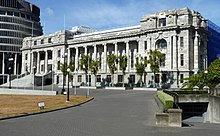36th New Zealand Parliament
| 36th Parliament of New Zealand | |||||
|---|---|---|---|---|---|
| |||||
 | |||||
| Overview | |||||
| Legislative body | New Zealand Parliament | ||||
| Term | 12 March 1970 – 20 October 1972 | ||||
| Election | 1969 New Zealand general election | ||||
| Government | Second National Government | ||||
| House of Representatives | |||||
 | |||||
| Members | 84 | ||||
| Speaker of the House | Alfred E. Allen from 7 June 1972 — Roy Jack until 9 February 1972 | ||||
| Prime Minister | Jack Marshall — Keith Holyoake until 7 February 1972 | ||||
| Leader of the Opposition | Norman Kirk | ||||
| Sovereign | |||||
| Monarch | Elizabeth II | ||||
| Governor-General | Denis Blundell from 27 September 1972 — Arthur Porritt until 7 September 1972 | ||||
The 36th New Zealand Parliament was a term of the New Zealand Parliament. It was elected at the 1969 general election on 29 November of that year.
1969 general election
The 1969 general election was held on Saturday, 29 November.[1] A total of 84 MPs were elected; 55 represented North Island electorates, 25 represented South Island electorates, and the remaining four represented Māori electorates; this was an increase in the number of MPs by four since the 1966 election.[2] 1,519,889 voters were enrolled and the official turnout at the election was 88.9%.[1]
Sessions
The 36th Parliament sat for three sessions, and was prorogued on 20 October 1972.[3]
| Session | Opened | Adjourned |
|---|---|---|
| first | 12 March 1970 | 3 December 1970 |
| second | 25 February 1971 | 17 December 1971 |
| third | 7 June 1972 | 20 October 1972 |
Ministries
The National Party had come to power at the 1960 election, and Keith Holyoake had formed the second Holyoake Ministry on 12 December 1960, which stayed in power until Holyoake stepped down in early 1972. He was succeeded by Jack Marshall, who formed the Marshall Ministry on 7 February of that year. The second National Government was defeated at the 25 November 1972 election.[4]
Overview of seats
The table below shows the number of MPs in each party following the 1969 election and at dissolution:
| Affiliation | Members | ||
|---|---|---|---|
| At 1969 election | At dissolution | ||
| National Government | 45 | 44 | |
| Labour Opposition | 39 | 40 | |
| Total |
84 | 84 | |
| Working Government majority | 6 | 4 | |
Notes
- The Working Government majority is calculated as all Government MPs less all other parties.
Initial composition of the 36th Parliament
The table below shows the results of the 1969 general election:
Key
National Labour Social Credit Independent
Table footnotes:
- ^ Sinclair was first on election night for Eden (by 35 votes), but lost when special votes were included
By-elections during 36th Parliament
There was one by-election held during the term of the 36th Parliament.
| Electorate and by-election | Date | Incumbent | Cause | Winner | |||
|---|---|---|---|---|---|---|---|
| Marlborough | 1970 | 21 February | Tom Shand | Death | Ian Brooks | ||
Notes
- ^ a b "General elections 1853–2005 - dates & turnout". Elections New Zealand. Archived from the original on 27 May 2010. Retrieved 2 December 2012.
- ^ Wilson 1985, p. 173.
- ^ Wilson 1985, p. 142.
- ^ Wilson 1985, pp. 89–92.
- ^ Norton 1988.
- ^ Gustafson 1986, p. 354.
- ^ Gustafson 1986, p. 381.
- ^ Templeton & Eunson 1972, p. 21.
- ^ Gustafson 1986, p. 380.
References
- Gustafson, Barry (1986). The First 50 Years : A History of the New Zealand National Party. Auckland: Reed Methuen. ISBN 0-474-00177-6.
- Norton, Clifford (1988). New Zealand Parliamentary Election Results 1946-1987: Occasional Publications No 1, Department of Political Science. Wellington: Victoria University of Wellington. ISBN 0-475-11200-8.
- Templeton, Ian; Eunson, Keith (1972). In the Balance: Election '72. Dunedin: John McIndoe.
- Wilson, James Oakley (1985) [First ed. published 1913]. New Zealand Parliamentary Record, 1840–1984 (4th ed.). Wellington: V.R. Ward, Govt. Printer. OCLC 154283103.
